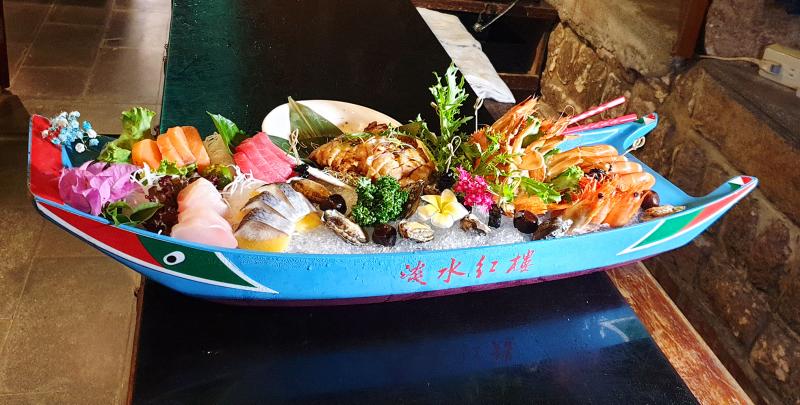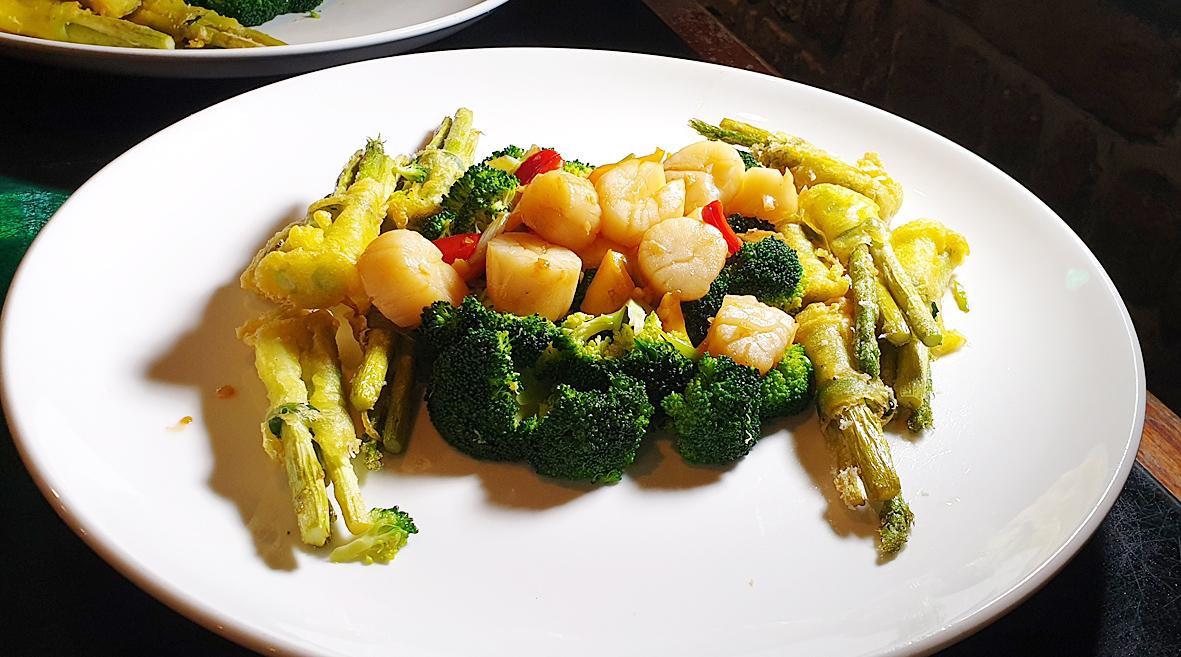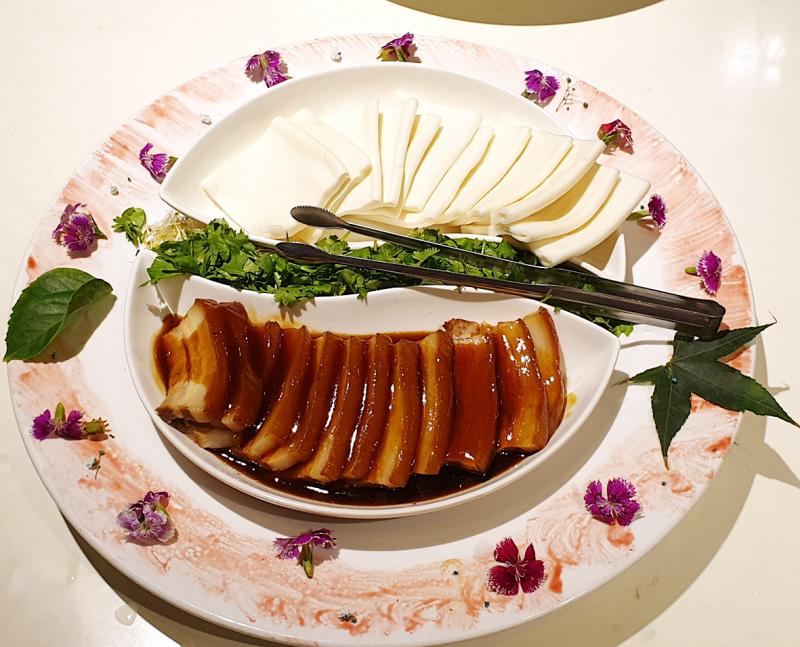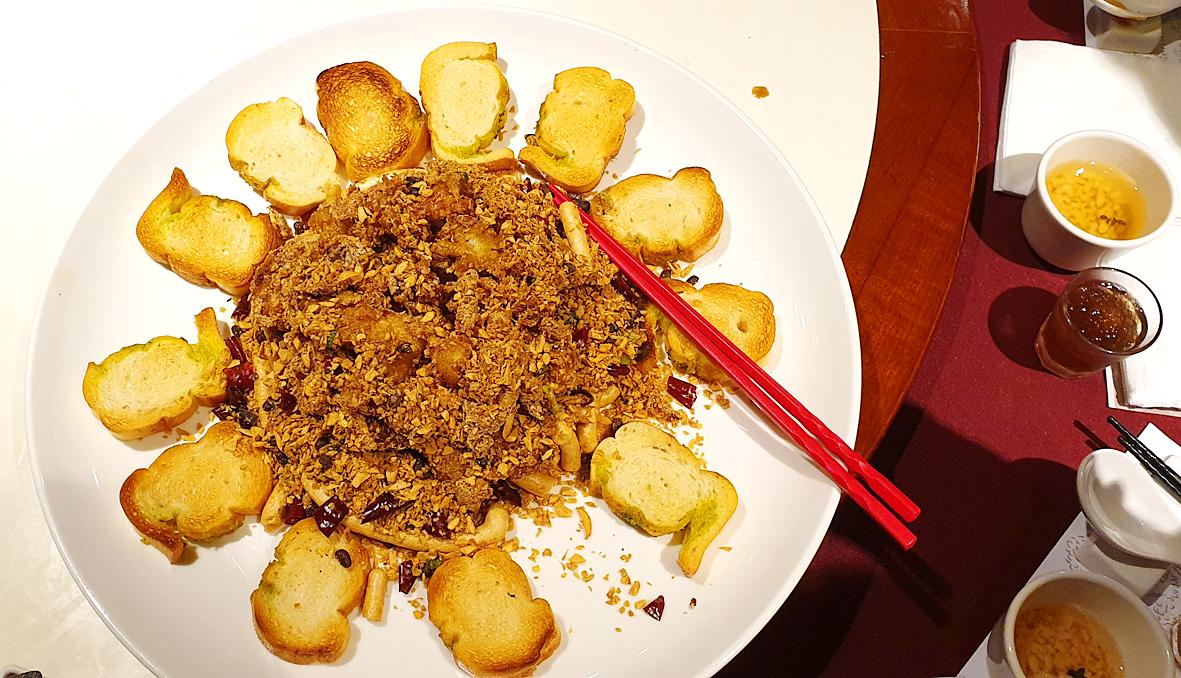Food can reflect culture, but can food also reflect history?
That was what Lee Chi-lin (李其霖), associate professor of history at Tamkang University (淡江大學) wanted to explore when he gathered historians, local officials and culinary enthusiasts at the Tamsui Red House (淡水紅樓), an exquisite red-brick Taiwanese cuisine restaurant built in 1899.
Lee planned the menu to reflect the historic Qing victory over the French in the Battle of Tamsui, also known as the Battle of Hobe (滬尾, Tamsui’s old name).

Photo: Katy Hui-wen Hung
On Aug. 23, 1884 war had broken out due to a territorial dispute in Vietnam between the French and Taiwan’s Qing Dynasty overlords.
After capturing Keelung, French warships appeared just outside Tamsui in early morning of Oct. 2 and bombarded the port. The French Fusiliers Marins launched a ground assault on Oct. 8, but defending forces drove out the invaders in just four hours.
The French defeat played a significant role in the Qing’s recognition of the strategic importance of controlling Taiwan and the imperial decision to separate Taiwan from Fujian as its 20th province in 1885.

Photo: Katy Hui-wen Hung
Lee’s 10-course menu illustrated significant aspects of the event. In battle storytelling fashion, Lee described each dish before it was served on the tables. However, gastronomic concerns over the order of the dishes took preference over the exact chronology.
Dish 1
“Reveille:” The call to battle begins with a beautifully decorated local seafood boat. The French coveted the port of Tamsui, regarded as a stronghold of maritime trade since the 17th century. Heavily armed, the invaders are represented by a large crab. The Qing, poorly equipped but numerous, are the smaller prawns. And an uninvited Japanese admiral, Heihachiro Togo, watches while eating sashimi on the battlecruiser Amagi. Black beans and iron eggs (a Tamsui specialty) depict planted spies, including a British pilot named Bentley, who went by the Italian name Carozzi.

Photo: Katy Hui-wen Hung
Dish 2
“Hobe Coastal Defense:” The local effort to fend off the invaders is presented by a mixed vegetable dish cooked with the popular French ingredients of scallops and asparagus. The asparagus tempura is arranged to resemble the 2km to 3km long fortification that locals built for the Qing army. Broccoli represents the grassy path to the battlefield and peppers the mangroves.
Dish 3

Photo: Katy Hui-wen Hung
“Crossing the Swamp:” This malabar spinach based “thick soup” made with finely chopped preserved eggs, pork, wolfberry and dried fish delivers both flavor and aesthetics. The green soup portrays the intense battlefield and the swampy land covered in paddy fields. Failing to diffuse the Qing’s naval mines, the French made a quick retreat in a boat shown by a flower in a small glass vase in the center of the dish.
Dish 4
“A-ho-da (阿火旦)” pocket meat: Local militia leader Chang Li-cheng (張李成) gathered about 500 Hakka and Aboriginal warriors (who were documented shooting flintlock rifles lying down with the barrel between their toes), pocketing a hard-won victory, hence the braised pork belly in steamed pancake pockets. Chang’s nickname A-ho-da is reportedly an amalgamation of his fiery temperament and his playing of female roles in traditional opera troupes.

Photo: Katy Hui-wen Hung
Dish 5
“Ba-ba softshell crab:” A heap of fried garlic, ginger and chili surrounded by a circle of toasted bread paints the panicking French encircled by the Qing army. Ba-ba, which approximates the sound of a bugle, refers to the wounded bugler who was unable to deliver the French commander’s orders to ease-up firing and conserve ammunition. The French soldiers’ knees buckled and their legs trembled with fear. Like a softshell crab, they accepted defeat and started to retreat.
Dish 6

Photo: Katy Hui-wen Hung
Ribs with dijon mustard on cabbage: Upon landing on Shalun Beach (沙崙), the French forces were neatly arranged in lines of 10 squadrons and companies. The ribs are marinated in French mustard and served on shredded cabbage.
Dish 7
Bass with chopped chili: This creation represents the French hopes of catching a fresh fish (Tamsui) only to be taught a bitter lesson, repulsed by the mountains of obstacles (chili) the defenders built.

Photo: Katy Hui-wen Hung
Dish 8
“Xiang Army fried rice:” Troops from the Qing’s Xiang (Hunan Province) and Huai (Anhui Province) armies were in charge of defending Taiwan. This tumeric rice dish includes General Tso chicken representing the Xiang and cranberry the Huai, and black sesame the hardy Hunan yong (勇, brave) warriors. It’s said that even the severely wounded yong rushed straight back to the battlefield after being patched up at the local Mackay Clinic, founded by renowned Canadian missionary George Leslie Mackay.
Dish 9

Photo: Katy Hui-wen Hung
“Mangrove soup:” Soon after landing at Shalun Beach, the low growing thorny mangrove bushes and sharp edged screwpines disoriented the French and hindered their advance. These two natural defensive plants form the idea behind the clear soup: Yellow dried daylily and white wood ear fungus represent the screwpine and mangroves, respectively, due to their shapes.
Dish 10
“General’s crispy taro:” The final dish pays tribute to General Sun Kai-hua (孫開華), who led the successful defense of Tamsui. However, Qing imperial commissioner Liu Ming-chuan (劉銘傳), who failed to defend Keelung, tried to steal Sun’s thunder by claiming victory for himself and his faction in official reports, even accusing Sun of dereliction of duty. Taro was reportedly Sun’s favorite food and an important staple in both Tamsui and Sun’s hometown in Hunan. It is served deep-fried, coated in peanut and sesame.

Photo: Katy Hui-wen Hung
TEA INSTEAD OF WINE?
“Hobe tea rice” is a local staple that locals enjoyed in 1884, Lee explains.
It is typically served in a bowl of brown indica rice, which is good for digestion, with tea poured in just before serving.
At the beginning of the banquet, a symbolic tablespoon of polished white rice in a small cup of oolong tea was offered, with tea served throughout the affair.
French gourmands would probably question why wine was not served. The heroic General Sun would too, as he was a known wine lover who was reportedly seen sipping champagne leisurely in the shade of a tree during the French bombardment.

The Nuremberg trials have inspired filmmakers before, from Stanley Kramer’s 1961 drama to the 2000 television miniseries with Alec Baldwin and Brian Cox. But for the latest take, Nuremberg, writer-director James Vanderbilt focuses on a lesser-known figure: The US Army psychiatrist Douglas Kelley, who after the war was assigned to supervise and evaluate captured Nazi leaders to ensure they were fit for trial (and also keep them alive). But his is a name that had been largely forgotten: He wasn’t even a character in the miniseries. Kelley, portrayed in the film by Rami Malek, was an ambitious sort who saw in

Last week gave us the droll little comedy of People’s Republic of China’s (PRC) consul general in Osaka posting a threat on X in response to Japanese Prime Minister Sanae Takaichi saying to the Diet that a Chinese attack on Taiwan may be an “existential threat” to Japan. That would allow Japanese Self Defence Forces to respond militarily. The PRC representative then said that if a “filthy neck sticks itself in uninvited, we will cut it off without a moment’s hesitation. Are you prepared for that?” This was widely, and probably deliberately, construed as a threat to behead Takaichi, though it

Among the Nazis who were prosecuted during the Nuremberg trials in 1945 and 1946 was Hitler’s second-in-command, Hermann Goring. Less widely known, though, is the involvement of the US psychiatrist Douglas Kelley, who spent more than 80 hours interviewing and assessing Goring and 21 other Nazi officials prior to the trials. As described in Jack El-Hai’s 2013 book The Nazi and the Psychiatrist, Kelley was charmed by Goring but also haunted by his own conclusion that the Nazis’ atrocities were not specific to that time and place or to those people: they could in fact happen anywhere. He was ultimately

Nov. 17 to Nov. 23 When Kanori Ino surveyed Taipei’s Indigenous settlements in 1896, he found a culture that was fading. Although there was still a “clear line of distinction” between the Ketagalan people and the neighboring Han settlers that had been arriving over the previous 200 years, the former had largely adopted the customs and language of the latter. “Fortunately, some elders still remember their past customs and language. But if we do not hurry and record them now, future researchers will have nothing left but to weep amid the ruins of Indigenous settlements,” he wrote in the Journal of